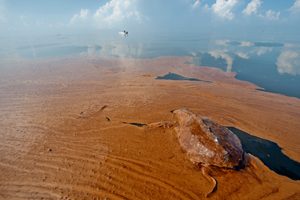
BP Underestimated The Extent Of Deepwater Horizon Oil Spill. It has now been confirmed that BP and the federal government severely underestimated the true extent of the Deepwater Horizon oil spill. Yesterday, a U.S. government panel studying the flow said the well was gushing oil at a rate of 12,000 to 19,000 barrels a day. […]

BP Underestimated The Extent Of Deepwater Horizon Oil Spill. It has now been confirmed that BP and the federal government severely underestimated the true extent of the Deepwater Horizon oil spill.
Yesterday, a U.S. government panel studying the flow said the well was gushing oil at a rate of 12,000 to 19,000 barrels a day.
For weeks, BP and the government had maintained that only around 5,000 barrels per day had been coming from the well. That estimate, based on satellite imagery of the oil slick on the surface of the water, was roundly criticized by many experts as being far too low. Getting an accurate estimate of the oil leaking into the Gulf is vital, as it will help determine BP’s liability for the disaster.
The government panel, the Flow Rate Technical Group, said yesterday that based on the midpoint of its best estimates, the well may have leaked about 527,000 barrels between the time the oil rig sank, on April 22, through May 26. That has exceeded the 262,000 barrels spilled by the Exxon Valdez in 1989, and makes the Deepwater Horizon disaster the largest oil spill in U.S. history.
In more disturbing news, scientists say they have spotted a huge new plume of what they believe to be oil deep beneath the Gulf, stretching from the site of the leak north toward Mobile Bay, Ala. According to the Associated Press, it is suspected that the plume resulted from using chemicals below the surface at the leak site to break up the oil.
Yesterday, BP also conceded that the oil spill represented a major environmental catastrophe. For weeks, the company had maintained that damage to the marine environment along the Gulf Coast would be modest.
“It is clear that we’re dealing with a very significant environmental crisis and catastrophe,” CEO Tony Hayward told CNN’s American Morning earlier today.
When referring to the oil that is now washing up on the shores of Louisiana, Hayward admitted: “In that regard, we have failed to defend the shoreline to the degree and extent that we believed we could.”
Meanwhile, BP’s effort to plug the leaking well with a procedure called a “top kill” continue today. Yesterday, the Coast Guard said the top kill was going as planned. But last evening, BP said it had temporarily suspended the procedure around 11:00 p.m. Wednesday night. According to The New York Times, engineers decided to take the break when they saw that too much of the drilling fluid they were injecting into the well had escaped along with the leaking crude oil.
The top kill did resume last night around 7:00. This morning, U.S. incident commander Admiral Thad Allen said that it appeared the flow of oil from the well had stopped. But according to the Associated Press, BP has warned that it would be at least 48 hours before it could be determined if the procedure had been successful.
The company still says the chances of the top kill working stands at around 60 to 70 percent. However, as time passes, some of the procedure’s risks are being reduced.
If it does work, BP will inject cement into the well to seal it permanently.
The personal injury attorneys at Parker Waichman LLP offer free, no-obligation case evaluations. For more information, fill out our online contact form or call 1-800-YOURLAWYER (1-800-968-7529).


